Tacos Al Pastor: Mexican Tacos with Temperature Advice
If you’ve ever been to a real taqueria or even an especially good taco cart, you’ve probably tried delicious tacos al pastor. The chile-spiked, cumin-scented, pineapple-basted spits of thin-sliced pork that inhabit the kitchens of quality Mexican restaurants yield tacos that are mouthwateringly crave-able.
If you’ve ever thought you’d like to get all the deliciousness of al pastor tacos at home, you aren’t alone. In this post, we bring you the secrets to perfect homemade tacos al pastor. And good news: you can make them without a spit! So this Cinco de Mayo, use a great thermometer like the ThermaQ® Blue and get taqueria-quality tacos in the comfort of your own kitchen.
What are tacos al pastor?
The name “al pastor” means “in the style of the shepherds,” and that name is a clue to the dish’s origin. Starting in the 1890s, there was an influx of immigrants to Mexico from what is now Lebanon. In the decades that followed, over 100,000 Arabic-speaking Lebanese immigrants came to Mexico, bringing with them their own foodways and recipes. One of these dishes was the Shawarma, also called Döner or Gyro. It consisted of thinly sliced meat, usually lamb, that was roasted on a slowly-turning vertical spit. The Mexican population adopted the delicious dish and, as a majority of the immigrants were shepherds, named it after them: tacos al pastor.
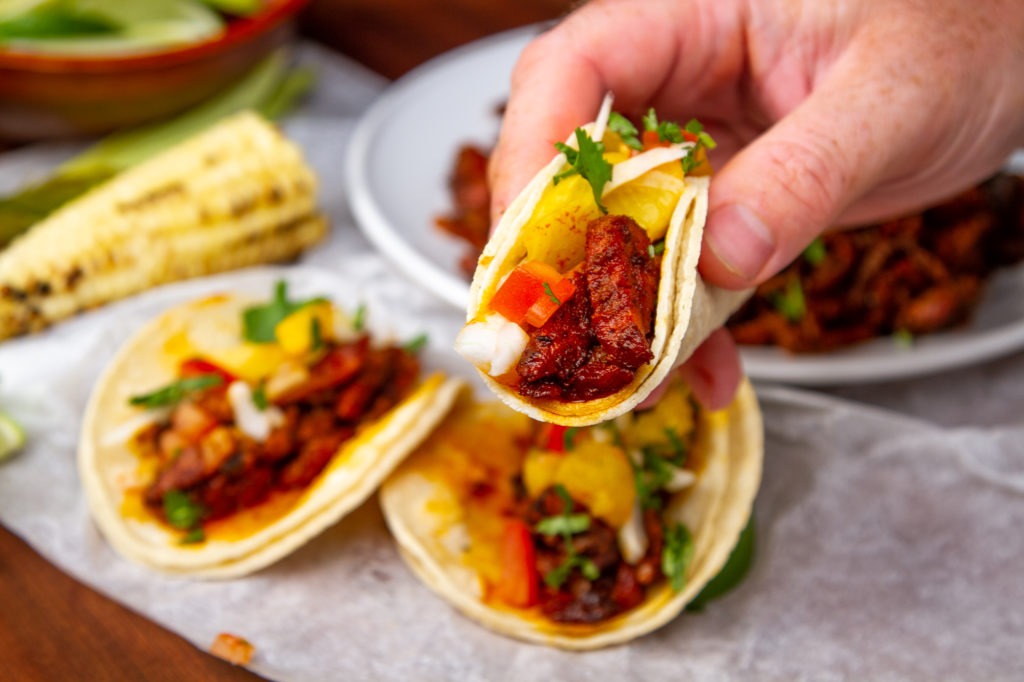
Once shawarma/döner was translated into a Mexican dish, it transformed completely. Though the original dish made by the Lebanese immigrants was almost surely made of lamb, it was quickly converted to pork. The Mediterranean spice palette was dropped in favor of chilies, annatto, and cumin, and pineapple was added to the top of the roasting spit. Tacos made in this manner are now a classic, beloved by taco aficionados everywhere.
How to make tacos al pastor at home
For the taco lover, homemade al pastor tacos may seem out of reach; after all, most of us don’t have large vertical roasting spits on which to cook the meat. But the clever cooks at SeriousEats.com have cracked the code and found a way to make mountains of meat for al pastor tacos. The key is to layer thinly sliced meat in a loaf pan, cook it to the proper temperature, chill it, then slice the loaf into thin pieces as if you were carving off of a large spit. Taco Tuesday may never be the same ….
Meat selection
The first key to proper tacos is meat selection. Traditionally, tacos al pastor are made with layers upon layers of pork shoulder, and if you have a real butcher, Korean grocer, or Mexican carniceria near you that will slice it thinly on an electric slicer, that is the very best option. If you can’t find a butcher that will provide that service for you, J. Kenji López-Alt recommends using pork sirloin, which can easily be sliced rather thinly and then pounded out to final thinness between sheets of plastic wrap. If you use the sirloin, you should include a quantity of bacon in your layering to make up for the fattiness of the pork shoulder. If you use the pork shoulder and still want to include a little bacon in the mix, who are we to say no? I did it, and it was delicious.
Marinade
The delicious flavor of tacos al pastor comes from the meat marinade. The base for the marinade is dried chilies which are toasted in a hot dry skillet until they are pliable and browned, then soaked in hot chicken stock. For deeper color and flavor, a fried paste of annatto powder (called achiote in Spanish), chipotle chiles in adobo, ground cumin, and Mexican oregano is added. The marinade is made by blending together the rehydrated chiles, their soaking liquid, the annatto/chipotle paste, and a splash of vinegar. Marinate the thinly sliced meat in the beautiful red slurry for at least 4 hours, but overnight is better.
Form a loaf and cook
The secret to getting rotisserie-style meat shavings is to form your sliced meat into a loaf before cooking. By packing it into a loaf pan, you force it to cook together into a cohesive shape. Then, once it is cooled, you can slice the loaf into thin little bits of taco meat.
Of course, forming the loaf is not enough to create tender, tasty taco meat. You also have to cook it right! The pork shoulder has loads of connective tissue that needs to be broken down, and that means slow cooking to a critical temperature. Collagen dissolution really gets going at about 170°F (77°C), so passing that temperature up is essential. But going for full-on fall-apart tenderness isn’t our aim: we’re not looking for shredded meat tacos. To create taco meat that is both tender enough to enjoyably eat and has enough structure to enjoy, cook the al pastor loaf to 180–190°F (82–88°C). Using a high-accuracy thermometer like the ThermaQ Blue will allow you to have greater control over your cook, and help you to achieve taco perfection. The ThermaQ Blue is also helpful because you can monitor the temperature readings from a distance, freeing you up to make your famous homemade salsa!
To get to that critical pull temperature, cook the meat in a medium-heat environment. 300°F (149°C) is a good temperature to cook at that will also brown the top of the loaf, adding toasty flavors to the tacos. You can do this in the oven, but cooking it over indirect heat in a grill is both more fun and more flavorful. Set up your grill for indirect cooking and monitor the air temperature with the ThermaQ’s air probe.
Slice the meat
After the taco loaf is cooked, it must be cooled before you can slice it. Remove the loaf pan from the smoker, grill, or oven, and allow it to cool on the counter for about a half hour before placing it in the refrigerator for a long chill, at least four hours. This chill will allow the rendered fat to congeal and will help set the shape of the cooked loaf.
Once chilled, remove the loaf from the loaf pan and scrape off any fat and any congealed juices. Separate the fat and the juices into two different bowls. Slice the loaf as thinly as you can and set the meat aside.
Brown the al pastor meat
To reheat the meat and give it those crispy edges that you would get on a roasting spit, melt a tablespoon or two of the reserved fat in a heavy-bottomed skillet over medium-high heat and add about half of the sliced pork to it. Cook it until it begins to brown and crisp, adding some of the reserved juices to bring flavor and moistness to the party. Your taco meat is ready!
Roast the pineapple
The pineapple at the top of an al pastor spit is usually carved, chopped, and served on the tacos. In our case, we have no spit and must, therefore, roast our pineapple separately. Cut up a fresh pineapple (though half a pineapple will be plenty) and spread it out on a lined baking sheet. Drizzle it with the remaining reserved pork fat, and roast in a 375°F (191°C) oven until the edges start to brown and caramelize. Let the pineapple cool until you can handle it, then chop it coarsely for service with the tacos.
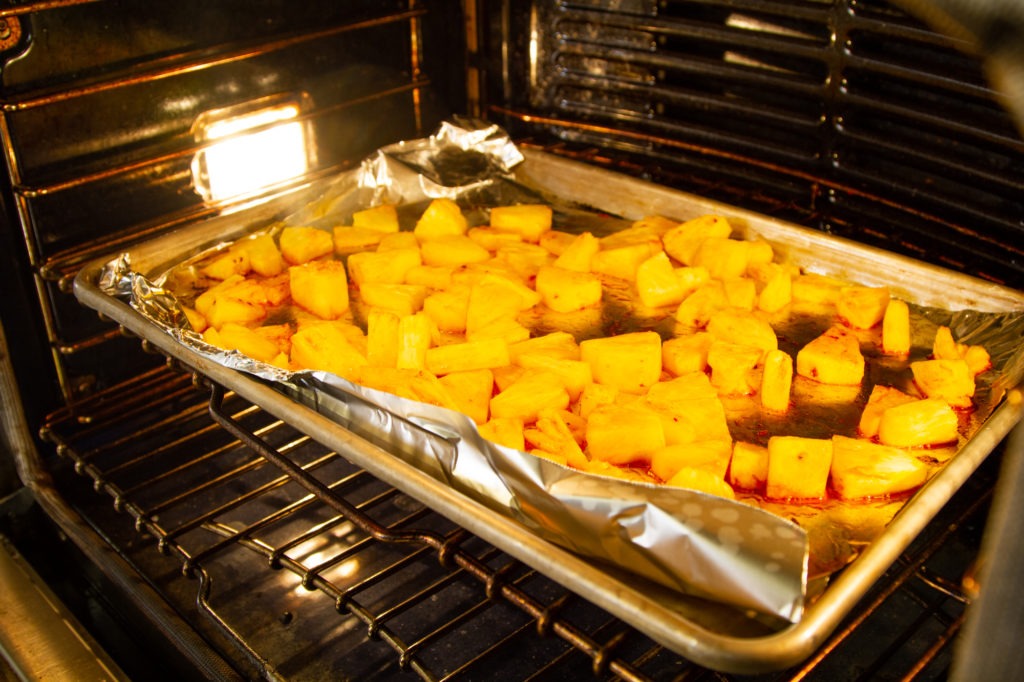
Now, you may be thinking about how the pineapple isn’t tenderizing the meat in this preparation. But in truth, it never is, even on the spit! Fresh pineapple contains enzymes that are amazing meat tenderizers, but there is not enough juice coming off of a pineapple on a large al pastor spit to penetrate the meat and tenderize it. It might run over the surface to some extent, but it is not tenderizing anything below that level. What it adds is delicious flavor and a bright acidic contrast to the fatty, richly flavored meat.
Tacos Al Pastor Recipe
Based on Real Tacos Al Pastor Recipe, by SeriousEats.com
Ingredients
For the pork:
- 2 whole ancho chilies, seeds and stems removed
- 2 whole guajillo chilies, seeds and stems removed
- ½ C chicken stock
- 2 tsp vegetable oil
- 1 tsp dried Mexican oregano
- 1 tsp ground cumin
- 1 Tbsp achiote powder or paste
- 1 or 2 chipotle chilies packed in adobo sauce, plus 2 tsp sauce from the can
- ¼ cup distilled white vinegar
- 3 whole cloves garlic
- 2 ½ tsp kosher salt
- 2 tsp sugar
- 2 lb boneless pork butt, sliced thin, about ⅛” thick
- 8 oz (½ pound) sliced bacon
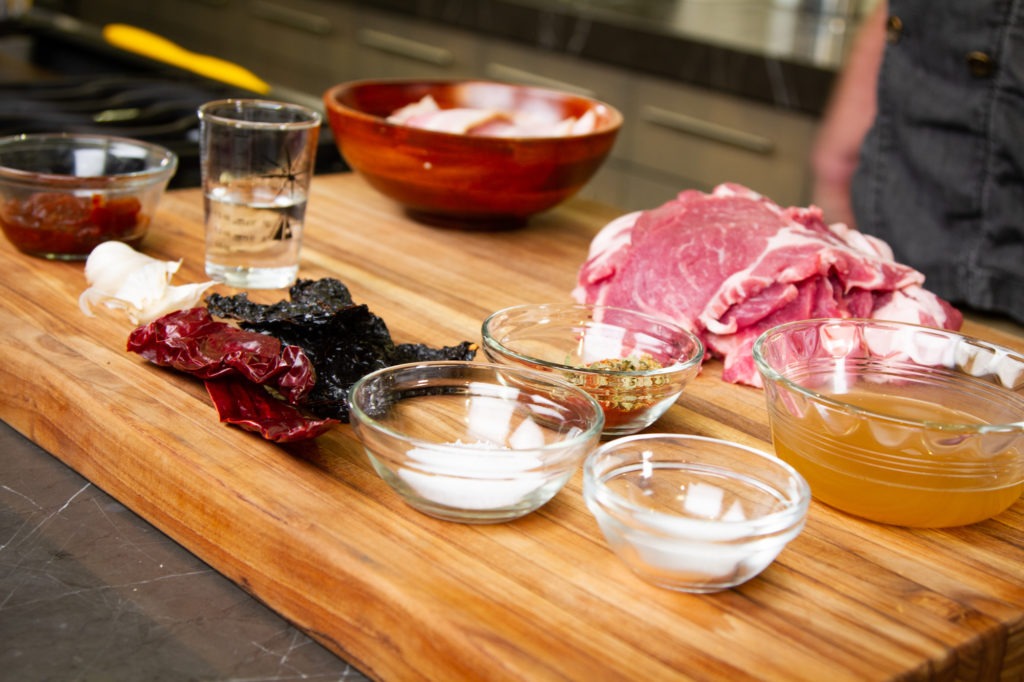
To serve:
- 1 small pineapple, peeled, cored, and cut into chunks
- 32 to 48 corn tortillas, heated and kept warm
- 1 medium white onion, finely diced
- ½ C finely minced fresh cilantro leaves and tender stems
- 1 C your favorite salsa (salsa verde is particularly good here)
- 3 to 4 limes, cut into 8 wedges each for serving
Instructions
Marinate the pork
- Heat a dry heavy-bottomed skillet over medium-high heat. Toast the chilies in the skillet until they become pliable, fragrant, and mottled with dark spots.
- Add the stock to the skillet with the chilies. It will boil immediately. Pour the stock and the chilies into a bowl and allow to soak. Wipe out the pan.

- Add the oil to the pan and heat over medium-high. Add the cumin, oregano, and achiote. Cook them until they are aromatic but do not let them brown, about 30 seconds. Add the chipotle chilies and the adobo sauce and cook another 30 seconds.
- Add the vinegar, sugar, and salt and remove the pan from heat.

- Place the chilies, their soaking liquid, the chipotle/spice paste, and the garlic cloves in a blender. Blend until very smooth, adding a little more water or stock if necessary to loosen the mixture.

- Once blended, allow the mixture to cool.
- In a large bowl, mix the sliced pork with the marinade, tossing to coat each piece.
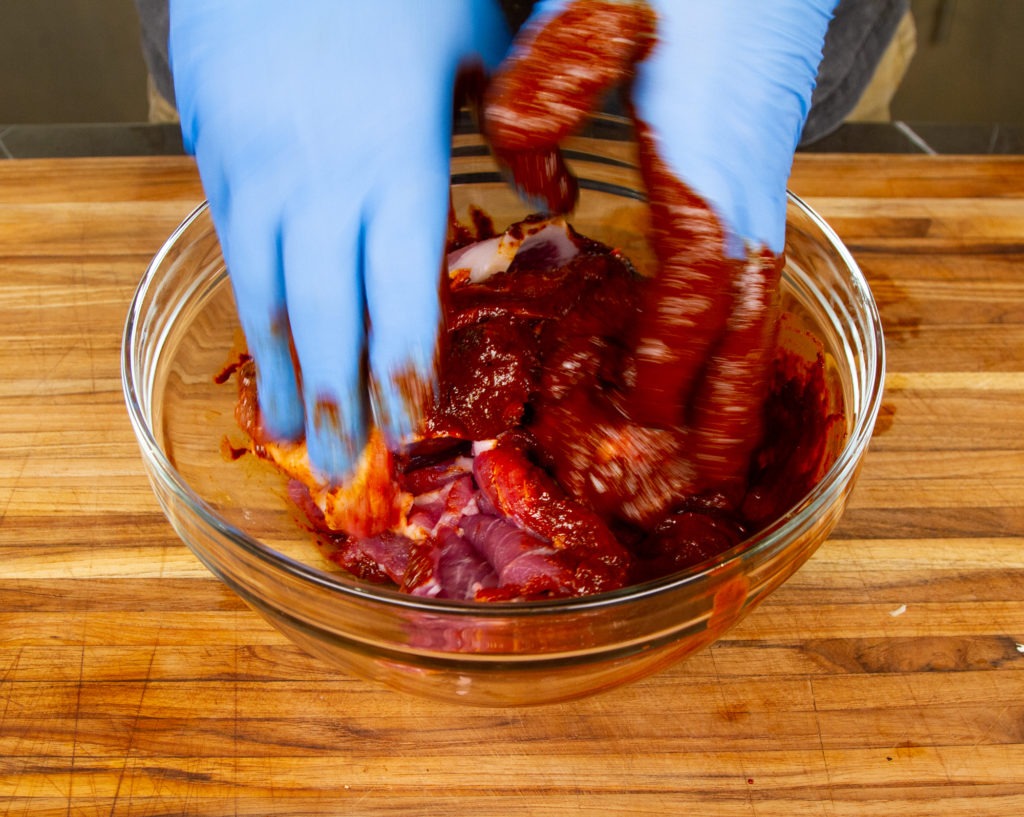
- Place a few strips of bacon on the bottom of a disposable aluminum loaf pan. Cover the bacon with a layer of marinade-coated pork. Alternate bacon/pork layers to fill the pan, pressing down if needed to fit everything into the pan.

- Wrap the pork loaf tightly in plastic wrap and refrigerate it overnight.
Cook the the loaf
- Set up your grill for indirect cooking. Use a two-channel thermometer like the ThermaQ Blue to establish the proper temperature, 300°F (149°C). Set the high alarm on your thermometer’s air probe for 325°F (163°C) and the low alarm for 275°F (135°C).
- Place the loaf of meat on the grill over indirect heat. (If you want to collect every bit of fat and juice, place the loaf pan inside another pan that can catch the drippings.)
- Insert the meat probe into the center of the pork loaf and set the high alarm on your thermometer for 185°F (85°C). Cook the pork.
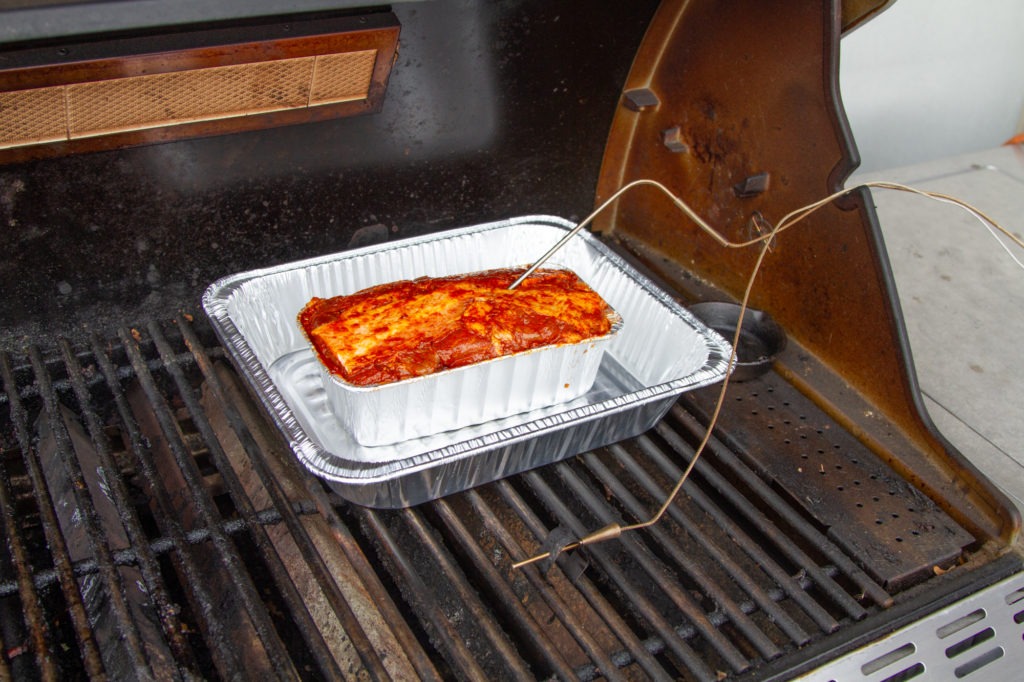
- When the meat alarm on your leave-in thermometer sounds, remove the loaf from the grill and cool it on the counter.
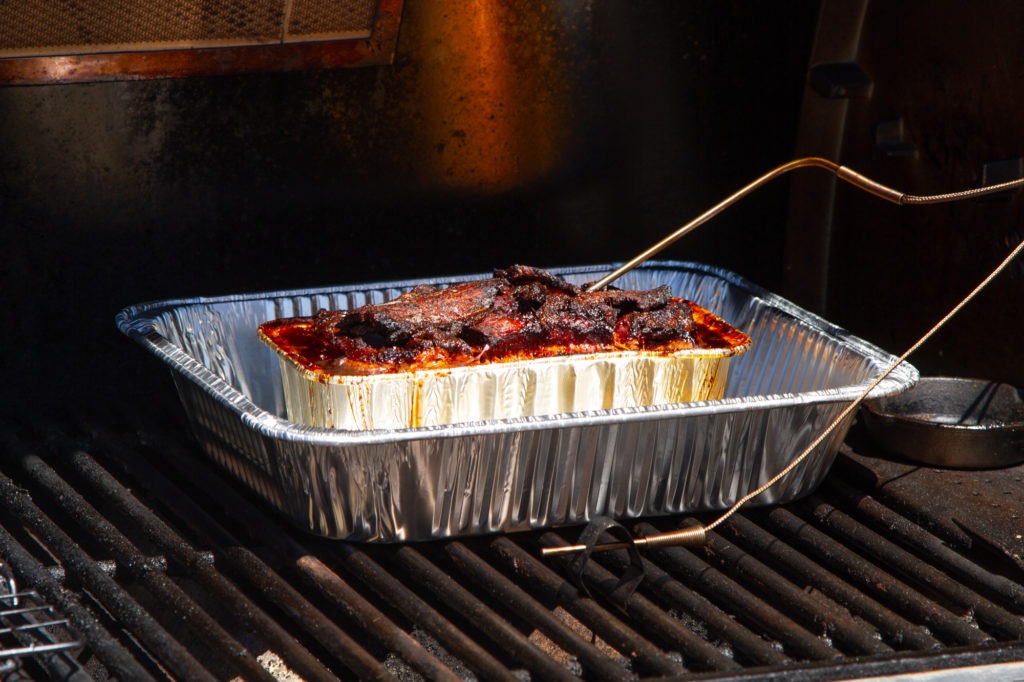
- Chill the loaf in the refrigerator for at least 4 hours.
Slice and cook the meat, cook the pineapple
- Preheat your oven to 375°F (191°C) and line a baking sheet with aluminum foil.
- Remove the meat from the loaf pan and save any juices, (liquid or congealed) as well as any solidified fat from the pan in separate bowls.
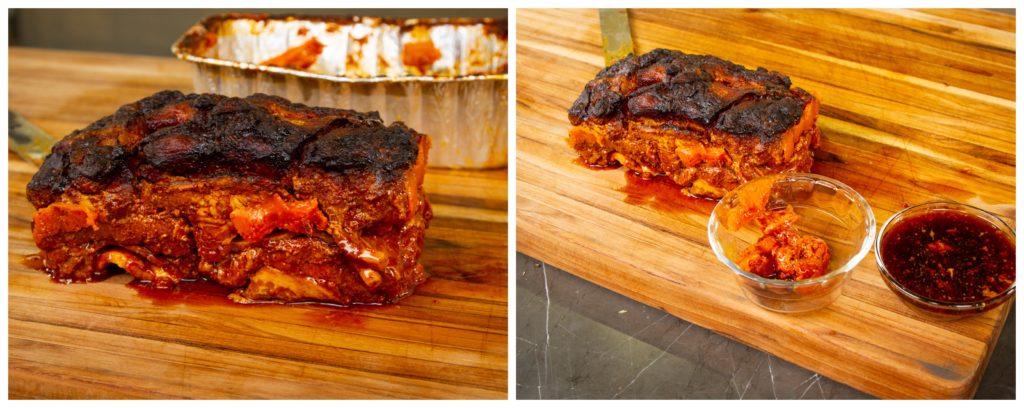
- Slice across the short end of the loaf with a very sharp knife, making cuts as thin as you can.
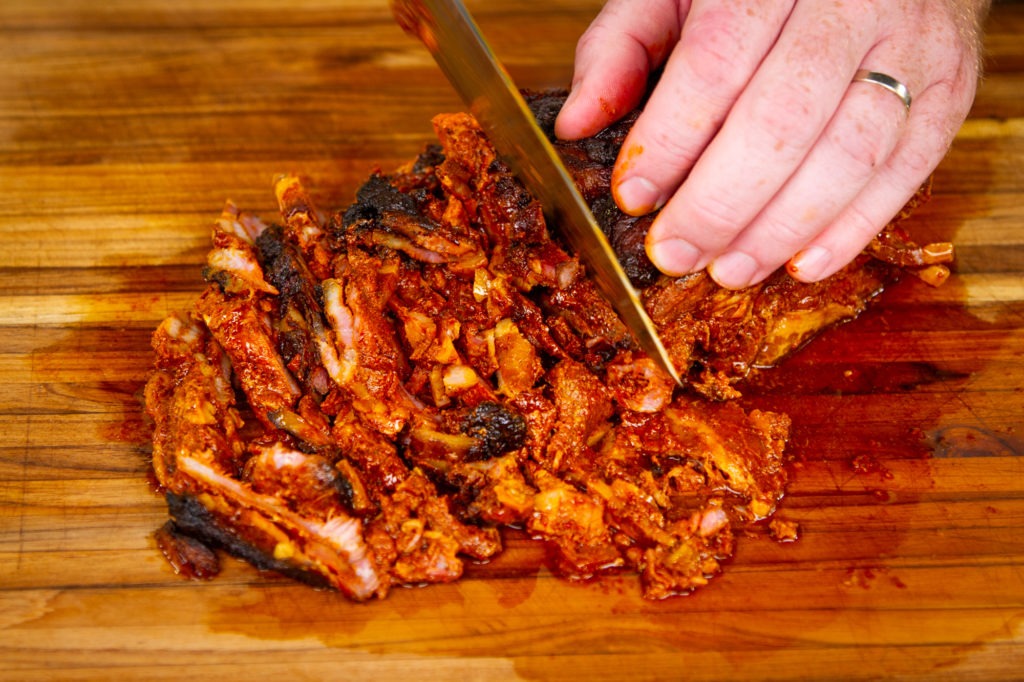
- Toss the pineapple chunks with half of the seasoned pork fat and spread them on the prepared baking sheet. Roast them until they brown on the edges, about 15-20 minutes.
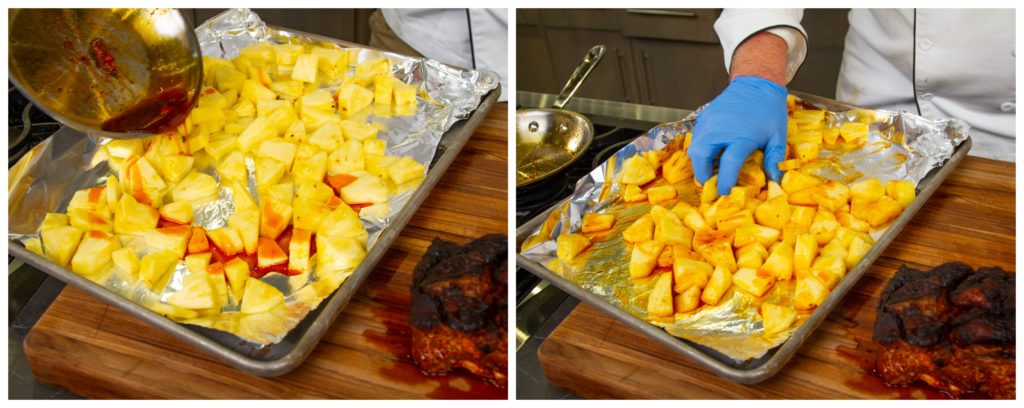
- When the pineapple is nearly done roasting, start cooking the pork.
- Add half the remaining fat to a heavy-bottomed skillet and heat it over medium-high heat.
- Add half the pork to the hot pan and cook it until the edges become crispy and brown.
- Add half the reserved juice from the loaf pan and cook until it is nearly dried out again.

- Remove the meat to a holding plate and cook the rest of the pork.
- Remove the pineapple from the oven and chop it coarsely.
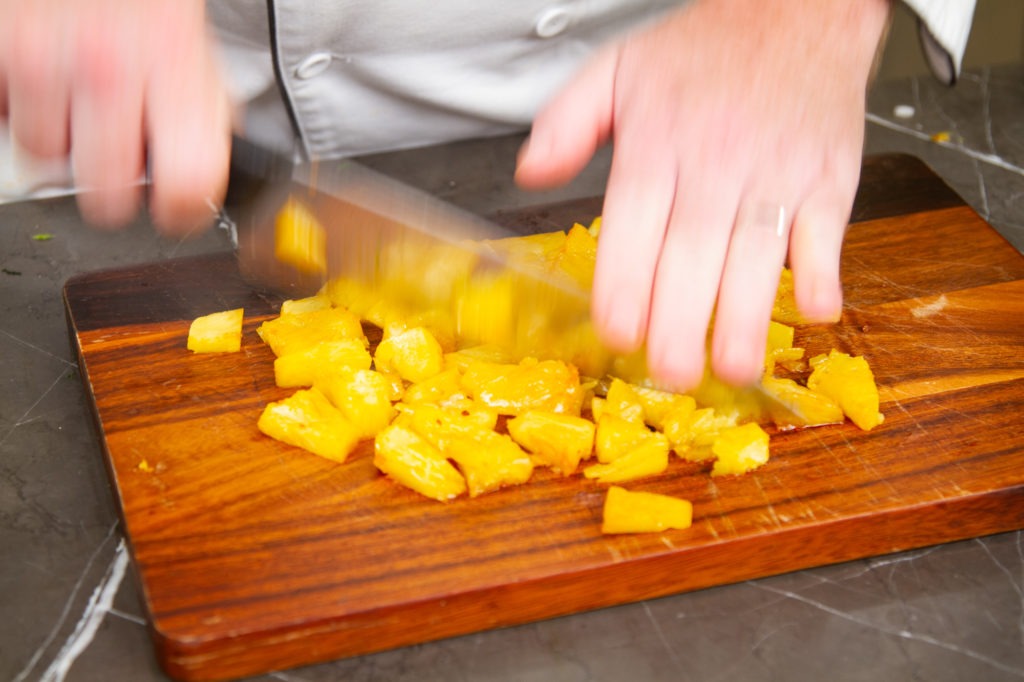
- Serve the al pastor pork with the pineapple, warm tortillas, and any taco fixings you like.
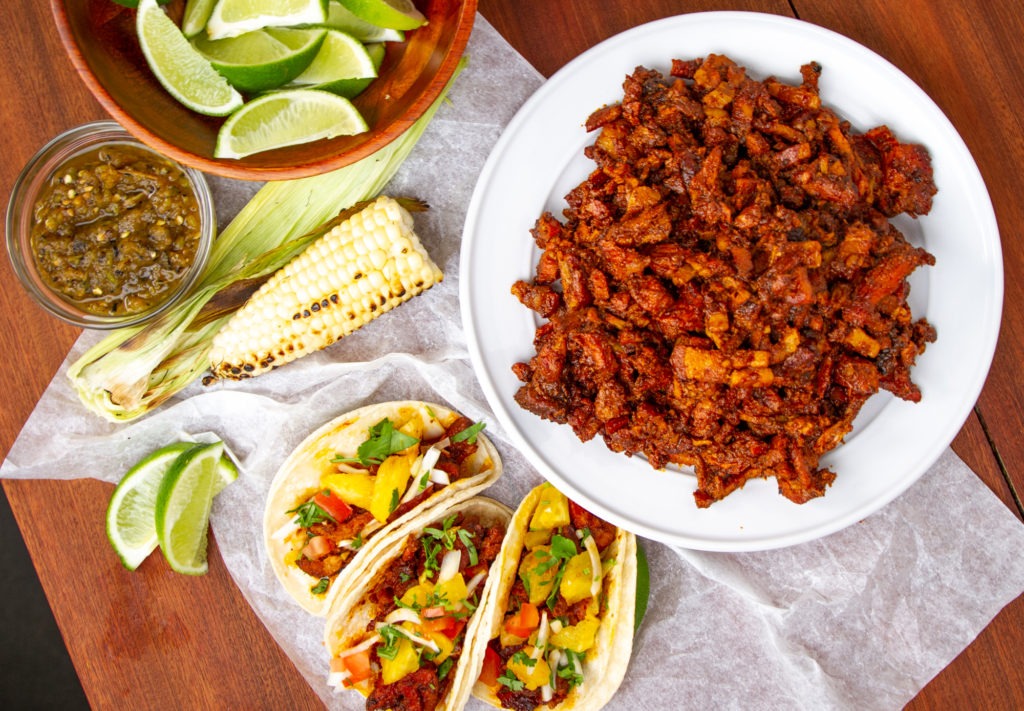
These tacos take a long time to prepare and to make, and you may be asking if it’s worth it. Yes. Yes, it is. They are amazingly flavorful, delicious tacos that you will want to make again and again. And with the help of a quality leave-in probe thermometer like the ThermaQ Blue (on sale now), you can easily cook the meat to tender-juicy perfection. Happy Cinco de Mayo!
Shop now for products used in this post:
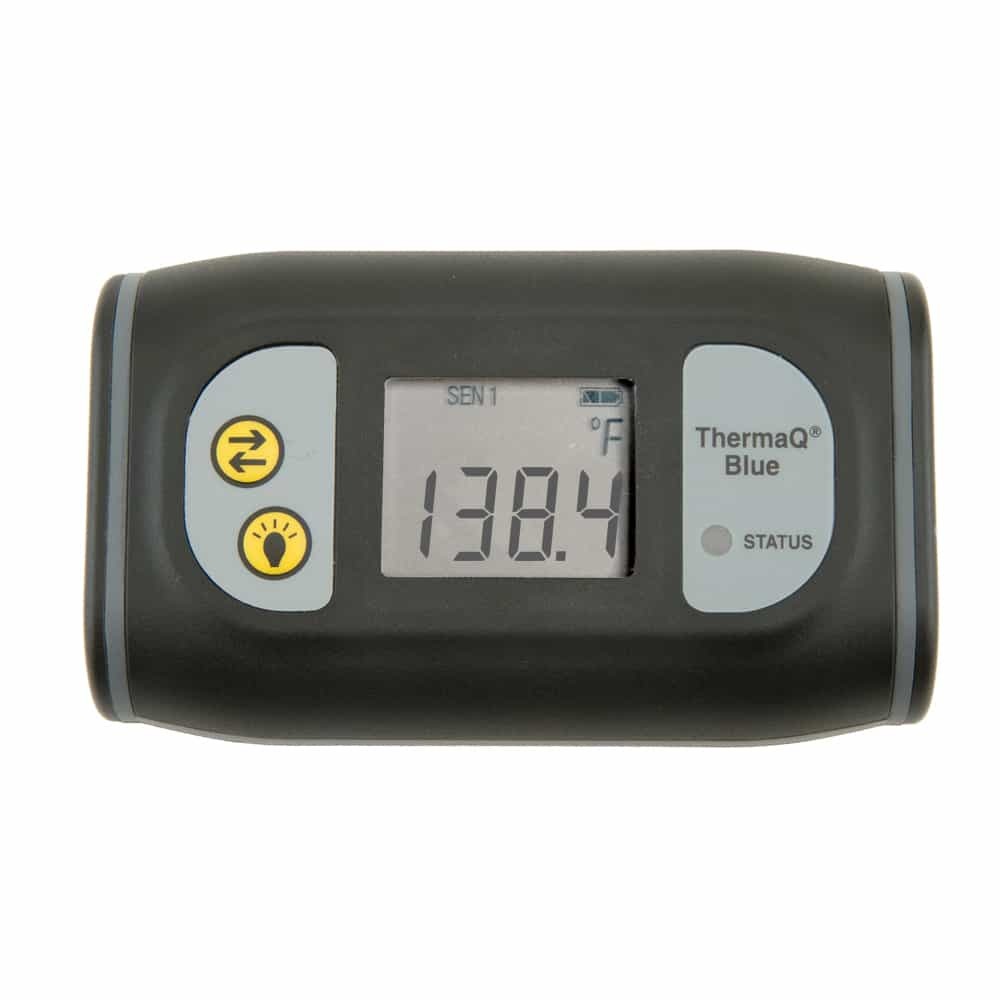


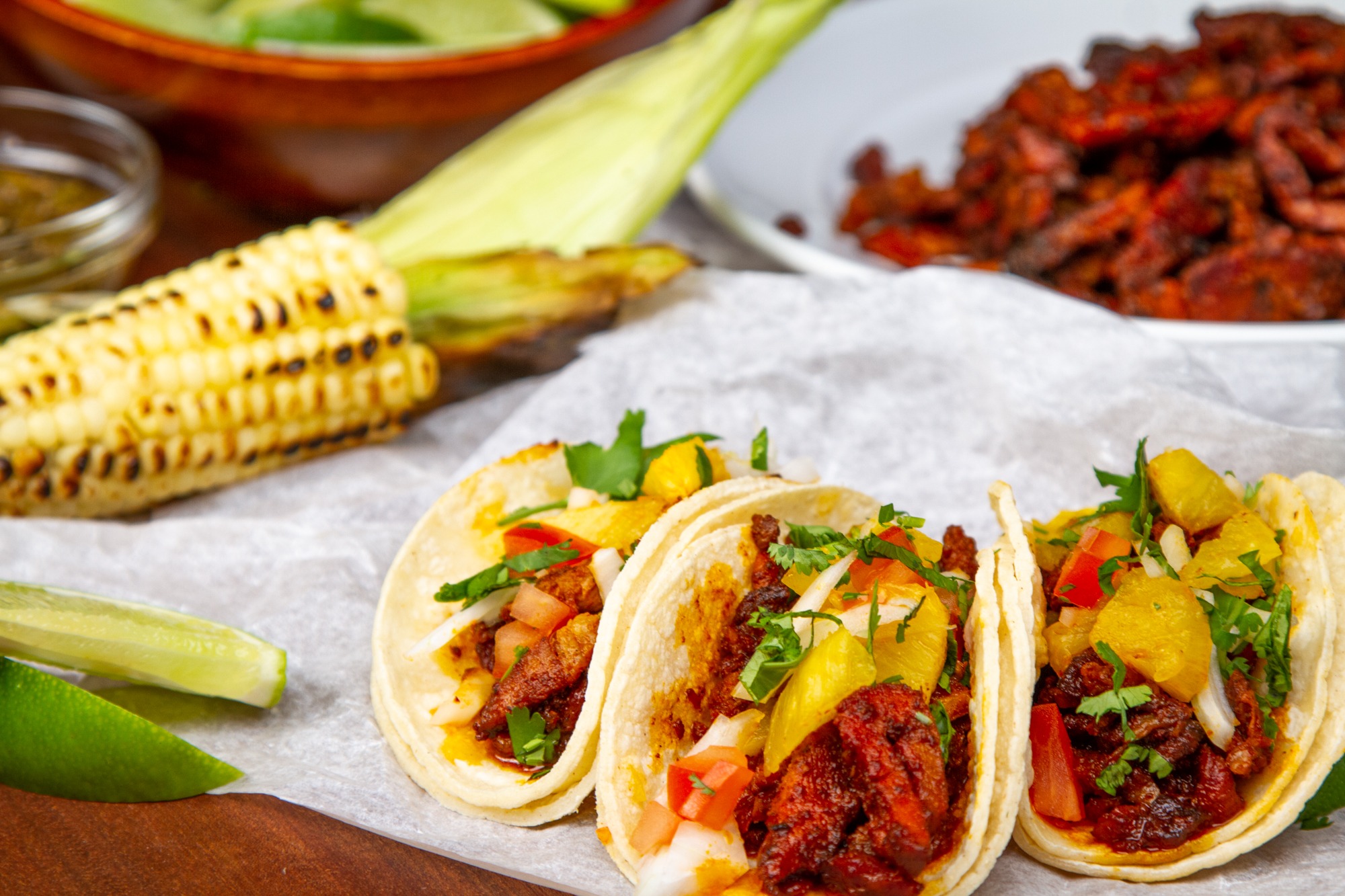
Looks awesome. I wonder if the meat could be ground in a food processor, a la Alton Brown’s gyro loaf recipe?
Glen,
You could do that, but it would take away some of the feeling of a true al pastor taco. Delicious? Yes! Authentic feeling? Not so much.
Suggest everyone try using the small limes usually called key limes in the US or Lemons in Mexico as-they adda far better local taste as compared to using the larger limes or lemons used for lemonade!
Agree!
This looks great. Believe it or not the typical food down here in Ecuador is pretty bland and we really miss Mexican & Tex-Mex since we moved from Houston.
I’m thinking of doing everything up through grilling the loaf then freezing for a party I’m doing in a week or so. Do you see a downside to doing it this way?
Wilbur,
No problem with that at all! In fact, you could make a few of them and always have on on hand in the freezer in case the craving strikes you. Happy cooking!